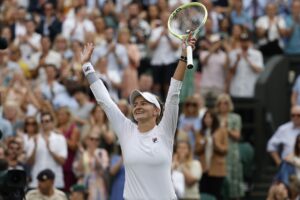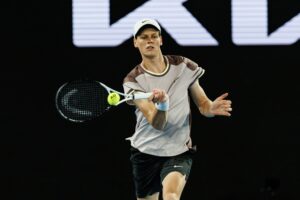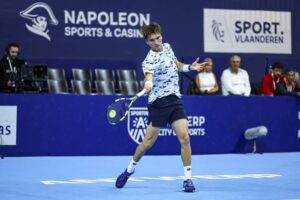It is rare for there to be a swan song without an audience, but that is exactly what is happening this week at London’s O2 Arena (or simply “the O2,” as it is usually called). As coronavirus restrictions continue to prevent tennis fans from seeing any live action, the final edition of the ATP Finals to be staged on the Greenwich Peninsula is being played out without crowds. Fortunately, the unique nature of the arena itself and even more importantly the staggeringly high quality of the tennis being played are ensuring that the tournament’s 12-year run in London will end with a bang and not with a whimper.
More than most sports, tennis can survive without a live crowd. It is usually the case on television that only the court itself is shown, neatly fitting within the dimensions of a television screen, and there are only occasional cutaways to the fans, usually in the breaks between games or sets. Consequently, it is easier for television coverage to hide or at least obscure the fact that there is no-one, or at most very few people, actually watching a tennis match. This certainly contrasts with most of the major team sports, particularly football, where it is almost impossible for TV coverage to hide the fact that there is no-one physically present in the stadium, which undoubtedly detracts from the viewing experience.
Even so, the O2 is particularly well-suited to coronavirus coverage of tennis; in fact, if you are going to have a tournament without fans, the place to have it is the O2. That is because from the start of the ATP Tour Finals’ tenure at the arena in 2009, the light show – or, more accurately, the dark show – inside the O2 has been an integral part of the presentation. Anyone who has ever attended the tournament there (and over the last 12 years, nearly 1.5 million fans have done so) will know that it is possible to completely “black out” the arena, save for the necessary exit signs. Traditionally, that has been used to heighten expectation among the crowd before the arrival of the players on court. This year, however, it has been used more or less permanently to try and disguise the fact that an arena designed to hold more than 17,000 people is occupied by, at most, 1% of that number.
It should be straightforward for every indoor venue to achieve this effect, but that is certainly not the case. An immediate and direct contrast can be made with the AccorHotels Arena in Bercy, which hosted the Paris Masters, the last major ATP event before the ATP Tour Finals. There, even for the semifinals and final, the arena was more or less constantly illuminated, making it absolutely impossible for anyone to forget that there was no-one in the stands, which inevitably had a draining effect on the atmosphere inside.
However, for all the undoubted merits of the O2’s lighting design, the real reason why the 2020 version of the ATP Tour Finals has been such a success is the quality of the tennis that has been played. Regardless of what happens at the weekend, when the semi-finals and Final will take place, it is possible to argue that the general standard of the play at the tour-ending event this time around has been the highest that it has ever been in London, and arguably the highest it has ever been since the first edition of the tournament in Tokyo in 1970.
That is because for once all eight players on display have been fit and raring to go. It is true that Roger Federer is absent, but the great Swiss effectively used the suspension of the tour in March, which eventually lasted until August, to undergo knee surgery, in the hope that he can make another phoenix-like resurrection in 2021 akin to his remarkable recovery from injury in 2017. However, the absence of the injured Federer has been offset by the presence, arguably for the first time ever at an ATP Tour Finals, of a fully fit and firing Rafael Nadal.
Traditionally, of course, Nadal arrives at the ATP Finals, if he arrives at all (and he has missed the tournament completely six times) in a state of near-physical collapse. The effect of his all-action style of play combined with the rigours of the North American hardcourt season in the late summer and early autumn usually mean that by November he is in no fit state to try and win the one truly important tournament that he has failed to win in his extraordinary career.
This year, however, the extended “mid-season break” enforced by the original lockdown, coupled with his own decision to avoid travelling to North America so that he could concentrate fully on winning a 13th French Open, has meant that he is in remarkably good shape, both physically and mentally. And that has showed in his play, particularly in the mini-epic that he played against Dominic Thiem in his second group-stage match.
It is arguable that there has never been a two-set men’s match anywhere that was as good as the Thiem-Nadal encounter at the O2 on Tuesday of this week. Both sets went to tie-breaks, both of which were narrowly won by Thiem, but overall there was an astonishingly high level of play. It is rare indeed to see two top players both playing at the top of their game simultaneously, but that was exactly what happened at the O2, in a classic case of one great player inspiring another great player to match him. That was perfectly demonstrated in miniature at the start of the second set when first Nadal, then Thiem, played seemingly impossible down-the-line winners that left their opponent standing breathless and amazed at the net.
The very fact that Nadal could recover so quickly–within 48 hours–from the disappointment of that defeat to knock out Stefanos Tsitsipas, the defending champion, and thus qualify for the semifinals for the first time in five years, is a testament to the relatively great shape that he is in at the end of this most disjointed of seasons. And the fact that Thiem then lost his “dead rubber” against the already-eliminated Andrey Rublev so limply showed how much the defeat of Nadal had taken out of him.
Fortunately for the fans watching on TV, the on-court brilliance has not been restricted to the London 2020 Group. In the Tokyo 1970 Group, there may not have been a classic contest to match that between Thiem and Nadal, but Daniil Medvedev’s destruction of Novak Djokovic, which at one point included his winning six straight games in a row against the World No.1, was no less memorable. As various commentators and writers pointed out, it is one thing to see Djokovic being so completely dominated on clay by Nadal, but to see him effectively being out-hit, out-thought and outran by anyone on an indoor court was virtually unprecedented.
Having won the Paris Masters, Medvedev–the Icabod Crane of Tennis, who always seems to have far more than four limbs whirling when he plays–has finally returned to the imperious form of his breakthrough summer of 2019, which culminated in his reaching the US Open final and narrowly losing to Nadal in the fifth set. The semifinal at the O2 on Saturday between the same two players may only be played over three sets, but after both players’ stunning performances this week it still has the potential to be a classic.
Finally, although the nature of the arena and the high quality of the play has allowed TV viewers to temporarily forget the absence of a crowd, the fans should not be forgotten completely. That is because the O2 has achieved in less than a dozen years what Wimbledon has failed to achieve in more than a century, namely opening up top-class tennis to ordinary British tennis fans.
Wimbledon may be the oldest and greatest tennis tournament in the world, but the fact remains that it is virtually impossible for anyone to attend it without either a debenture or a tent that they are prepared to sleep in overnight. By complete contrast, the infinitely greater availability of tickets to the ATP Finals at the O2 has allowed many British fans who have never been able to attend Wimbledon to see Federer, Nadal, Djokovic and all the other leading lights of the men’s game for the first time. That is something that the ATP should remember in the future, when it considers where to locate its end-of-season event after Turin, or even when it possibly considers where to locate a new Masters 1000 event. In both instances, London and its army of tennis fans should figure highly in its thinking.
Main Photo from Getty.






